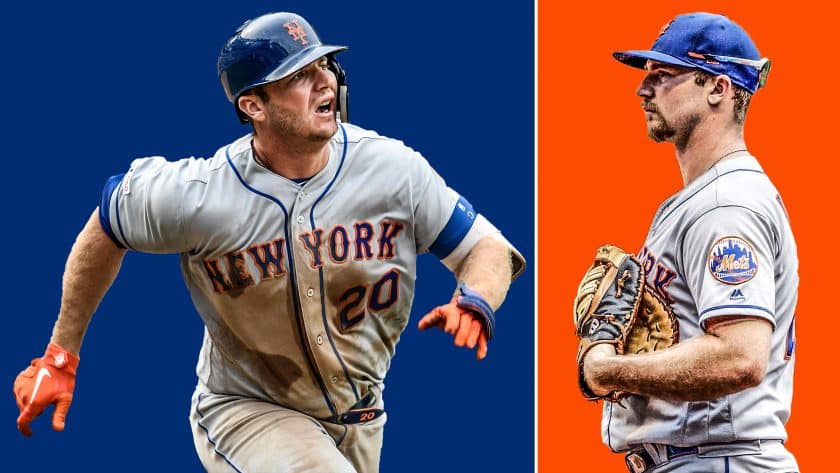New York Mets: The Pete Alonso velocity prophecy

Exit velocity may be the key to understanding why Pete Alonso‘s hot start is a sign of things to come for the New York Mets rookie.
[sc name=”Justin Birnbaum Banner”]On April 1, New York Mets first baseman Pete Alonso launched his first major league home run over the fence at Marlins Park in Miami—a towering 444-foot blast with an exit velocity of 112.8 miles per hour.
Ten days later, Alonso uncorked his masterpiece at SunTrust Park in Atlanta—a 454-foot line drive home run off the bat at 118.3 miles per hour, the hardest hit ball in the major leagues this season. If there’s one takeaway from this early season power surge, it’s that Alonso has established himself as the best young power hitter in baseball.
Given his minor league production—36 home runs between Double-A and Triple-A last year, as well as six during the Arizona Fall League—Alonso’s power is not surprising. Since debuting with the Mets in March, Alonso leads all qualified rookies with 11 home runs in 134 at-bats. Despite being the 48th ranked prospect by MLB.com entering this season, Alonso earned National League Rookie of the Month honors for March and April and has catapulted himself to the forefront of the National League Rookie of the Year debate.
What’s most impressive about the start to Alonso’s career, and indicative of his future success, is how hard he’s hitting the ball. Earlier this year, The Athletic’s Eno Sarris wrote an article explaining how meaningful exit velocity, a Statcast metric tracking how fast the ball leaves the bat, is as an early season statistic. Whereas swing and ground ball rates take time to stabilize, one hard hit ball can “actually make a case that your projection for the rest of the season should change.”
One year earlier, The Athletic’s Rob Arthur found a direct relationship between hard batted balls and players’ PECOTA projections (PECOTA is a proprietary player forecasting system released by Baseball Prospectus every year).
The magic number he found is 108 mph and for every mile above it on a batted ball, a hitter will gain roughly six points of on-base plus slugging percentage (OPS) relative to their projection. OPS combines on-base percentage and total bases to give a clearer picture of a player’s total offensive contribution.
As Arthur notes, PECOTA tends to be “skeptical with most unproven youngsters” which doesn’t make it all that surprising that Alonso is currently outperforming his projection. What is shocking is how much he’s surpassing his estimated OPS, beating PECOTA’s projected .762 by 204 points. Of all rookies with at least 120 plate appearances, Alonso has the greatest positive differential between OPS projections and actual results.
If the season ended today, Alonso would be the youngest player to sit atop the maximum exit velocity leaderboard in the five years since Statcast was introduced at all thirty MLB ballparks. At 24 years old, Alonso’s 118.3 mph home run from Atlanta, tied with Gary Sanchez’s 118.3 mph blast against the Minnesota Twins last week, is harder than any ball Mike Trout, Aaron Judge or Christian Yelich has hit this season. He’s crossed the 108-mph threshold 20 times in 2019, seven of which have come on home runs.
[sc name=”Mets Center”]Even outside of the rookie category, Alonso’s bat has found a way to stand out among all young players. Of players 25 years old or younger, Alonso ranks second in home runs tied with Joey Gallo (11) and behind Cody Bellinger (14).
Alonso has a slight edge over Gallo, with a 2.9 mph advantage on maximum exit velocity and four more instances of batted balls over 108 mph. With Bellinger, the difference is much more prominent. Alonso has a 7.7 mph lead on maximum exit velocity over Bellinger and has batted balls at or greater than 108 mph 16 more times.
However, there is one caveat worth considering when using exit velocity as a judge of future performance. To maximize the impact of one’s exit velocity, a hitter needs to lift his hardest-hit balls into the air. Balls hit hard into the ground provide less potential for beneficial results. Luckily for Alonso, his batted-ball distribution currently sits around league average. While this is inclined to fluctuate over time, his present tendencies are not on an extreme that would suggest an eventual correction.
With no signs of slowing down, Alonso’s ability to hit balls at high levels of exit velocity suggest this is not an early season fluke. A standout in his own age group, Alonso is not only making a strong case for the National League Rookie of the Year but proving his power will remain among the game’s elite power hitters.
[sc name=”Mets Link Next” link=”https://elitesportsny.com/2019/05/08/new-york-mets-1b-pete-alonso-answers-the-call-in-crucial-may-game/” text=”New York Mets 1B Pete Alonso Answers The Call” ]A former disciple of Stan Fischler. IBWAA member. Bylines at Baseball Prospectus Mets, Elite Sports New York, and my own creation: Baseknock MLB. Formerly Amazin' Avenue of SB Nation. Proud UAlbany Alum.






